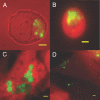Transformation of Anaplasma phagocytophilum
- PMID: 17076894
- PMCID: PMC1635035
- DOI: 10.1186/1472-6750-6-42
Transformation of Anaplasma phagocytophilum
Abstract
Background: Tick-borne pathogens cause emerging zoonoses, and include fastidious organisms such as Anaplasma phagocytophilum. Because of their obligate intracellular nature, methods for mutagenesis and transformation have not been available.
Results: To facilitate genetic manipulation, we transformed A. phagocytophilum (Ap) to express a green fluorescent protein (GFP) with the Himar1 transposase system and selection with the clinically irrelevant antibiotic spectinomycin.
Conclusion: These transformed bacteria (GFP/Ap) grow at normal rates and are brightly fluorescent in human, monkey, and tick cell culture. Molecular characterization of the GFP/Ap genomic DNA confirmed transposition and the flanking genomic insertion locations were sequenced. Three mice inoculated with GFP/Ap by intraperitoneal injection became infected as demonstrated by the appearance of morulae in a peripheral blood neutrophil and re-isolation of the bacteria in culture.
Figures



References
-
- Lukacova M, Valkova D, Quevedo Diaz M, Perecko D, Barak I. Green fluorescent protein as a detection marker for Coxiella burnetii transformation. FEMS Microbiol Lett. 1999;175:255–260. - PubMed
Publication types
MeSH terms
Substances
Grants and funding
LinkOut - more resources
Full Text Sources

